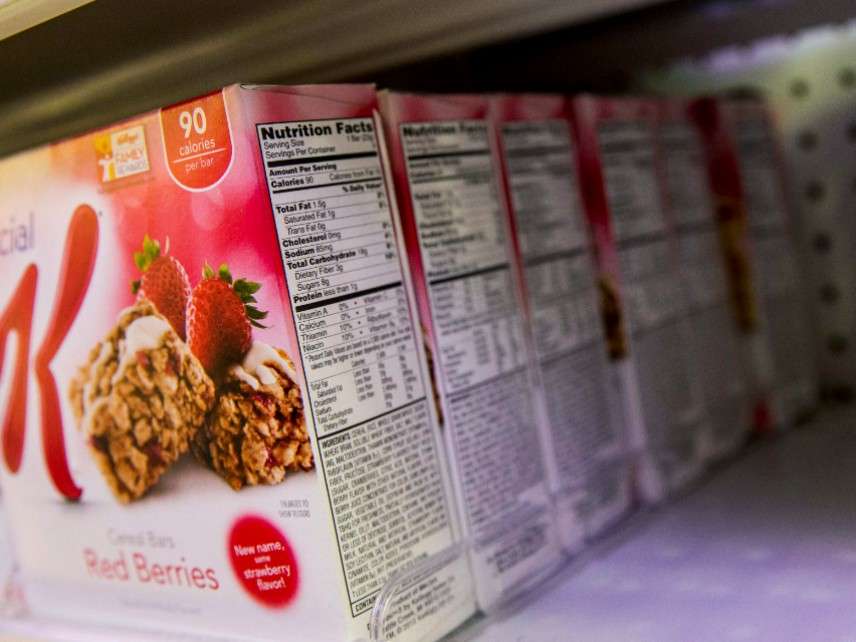The FDA's 'Added Sugar' Labeling Rule Is Sugar-Coated Nonsense
What exactly does an "added sugar" label tell us that the existing total sugar label does not? Nothing worthwhile.

The FDA announced last week that it had decided not to require producers of sugar, honey, or maple syrup to label their products as containing "added sugar," under the agency's ongoing implementation of rules finalized in 2016 under then-Pres. Obama.
As the FDA explained in its announcement, requiring makers of foods that contain no added sugars to state otherwise could "inadvertently lead consumers to think their pure products, such as a jar of honey or maple syrup, may actually contain added table sugar or corn syrup because there are 'added sugars' listed on the label."
You think?
Indeed, forcing makers of maple syrup or honey, which contain no added sugars, to lie and claim their foods do contain added sugars never made any sense. Still, the reversal of course comes after the FDA took some months to ponder its baffling opinion that added sugars include both the obvious (sugars added to food) and the tortured (sugars "packaged as such," whatever that means).
"In one way it makes no sense at all," wrote Patrick Clinton of the New Food Economy (where I also contribute), in a piece on the FDA's "added sugar" label this summer. "But in another way it reveals a lot about the Regulatory Mind."
Which is to say, regulators and regulations often make no sense at all.
In his announcement last week, FDA Commissioner Scott Gottlieb defended the "added sugar" label as "empowering consumers with accurate and science-based information to help them make more informed, healthier choices." Nope. It turns out the FDA's requirement that food makers include an "added sugar" designation on others foods that do contain added sugar doesn't make any sense, either.
First off, the FDA has required a food product's amount of total sugar per serving to appear on food labels for decades. But the creation of an "added sugar" label was one of the signature food-policy changes championed several years ago by then-First Lady Michelle Obama, who dubbed the label "a huge deal." It was a huge deal, the White House boasted in 2016, because the added sugar label will—wait for it—"help consumers know how much sugar is added to the product."
Despite that underwhelming tautology, supporters of the "added sugar" label clamored for its arrival. The Center for Science in the Public Interest characterized the "added sugar" label as "critical information [consumers] need to make decisions," while some food companies have adopted the labels ahead of any formal deadline and want the FDA to force their competitors to do the same.
But what exactly does an added sugar label tell us that the existing total sugar label does not? Nothing worthwhile. As I've written time and again, the whole premise behind the "added sugar" label itself is flawed and misleading.
First and foremost, it's deeply confusing. The current, accurate, and appropriate requirement to list total sugars per serving includes any and all sugars that occur naturally in a food (e.g., those in a fruit that is itself an ingredient in a food) plus any sugar (e.g. cane sugar) that's added by the food manufacturer. The new requirement to also list added sugar seemingly exalts some high-sugar foods that contain no added sugar (such as orange juice) while stigmatizing foods with added sugar that may contain far less total sugar than that same orange juice.
If a person is trying to reduce the amount of sugar they consume, which of these hypothetical foods is healthiest?
- Food X contains 15g total sugar, including 0g naturally occurring sugar and 15g added sugar.
- Food Y contains 43g total sugar, including 43g naturally occurring sugar and 0g added sugar.
- Food Z contains 35g total sugar, including 26g naturally occurring sugar and 9g added sugar.
For a person who's limiting their sugar intake, the food with the most "added sugar"—Food X—is the least unhealthy choice, because it contains the smallest amount of total sugar. The food with no added sugar at all—Food Y—is clearly that person's worst option of the three, because it has the most sugar overall. But forcing food makers to include an "added sugar" label would, in the above scenario, likely steer a person away from the least unhealthy option. How can anyone possibly call that good policy?
As I wrote in a 2014 column, the FDA's stigmatization of "added sugar" is part of a larger agency campaign to paint a laundry list of food ingredients that are added to processed foods as the enemy. FDA regulators, I wrote, "are hard at work hunting down these ingredients and seeking to exorcise them—directly, or through stigmatization—from America's grocery shelves."
I support the FDA's requirement that food makers who sell across state lines label any and all ingredients that appear in packaged foods. And I accept the FDA's requirement that food makers also provide consumers with information about the nutrition contents of foods via a nutrition-facts label. But I neither support nor accept an added sugar label that serves to mislead, confuse, and cause potential harm to consumers.
Show Comments (48)